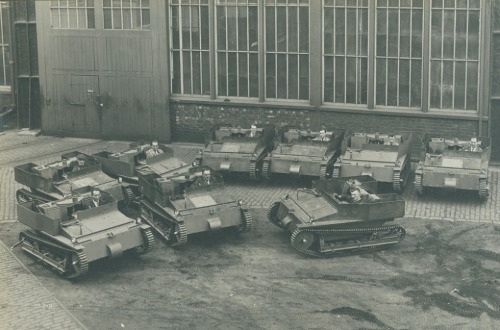Carden-Loyd Two-Man Tankette
The Vickers-Armstrong company built the first Carden-Loyd Tankettes in 1926, they were based on a design by the Carden-Loyd tractor company. They had a crew of two and were intended to act not as tanks but rather as machine gun or mortar carriers.
The early Carden-Loyd Tankette pictured above has a two man crew, a driver and a gunner, with a MkIII aerial Lewis Gun mounted in one of three slot in tankette’s front armour. Other variants had .303 Vickers guns mounted on the chassis. The Carden-Loyd Tankette, designed by Sir John Carden and Vivian Loyd, went on to inspire a number of other foreign tankettes, including the Soviet T-27, the Italian CV-33 and the Polish TKS.

A MkVI Carden-Loyd towing a 3.7 QF Howitzer MkI (source)
The Tankette concept first emerged during the inter-war period, theoretically creating a small, nimble, infantry tank capable of supporting advancing infantry or scouting ahead. Many countries including Britain, France, Italy Poland, Japan and the Soviet Union developed them before 1939.
While many tankettes mounted machine guns or even small canon and were often fully enclosed, the Carden-Loyd Tankette pictured above is open topped and has more in common with the Universal (or Bren Gun) Carriers that followed it.

Carden-Loyd Carriers pictured at the Elswick Works, Newcastle, c.1930 (source)
The Carden-Loyd was built in various Mks with the final MkVI being the most successful. It weighed 1.5 tons, was just over 8 feet (2.5m) long and had 6-9mm of hardened steel plate armour. It could reach up to 30mph, extremely fast compared to earlier light tanks, but its rudimentary suspension meant it was extremely unpleasant to travel in over rough ground or long distances. The Carden-Loyd Tankettes also had the distinction of being part of Britain’s short-lived, but influential, Experimental Mechanised Force with some Carden-Loyds acting as a reconnaissance element.
The Carden-Loyd’s legacy is the influence they had on international tankette development and the foundations they laid for the later Universal Carrier which proved an invaluable vehicle during the Second World War.
Sources:
Images: 1
The Illustrated Encyclopedia of Military Vehicles, I.V. Hogg & J. Weeks, (1980)
If you enjoy the content please consider supporting Historical Firearms through Patreon!
khlebs liked this
meaw2032 liked this
 east-n-roll liked this
east-n-roll liked this brosencrantz reblogged this from historicalfirearms and added:
I adore the tiny tanks.
tezzington liked this
 flynbryk-blog liked this
flynbryk-blog liked this  reinkep liked this
reinkep liked this potatothecabbage liked this
murderousautomaton liked this
efeightyeight liked this
warrior-of-the-skies liked this
kuperjanov liked this
beware04 liked this
 amaquin liked this
amaquin liked this quarian-fucker liked this
eduardrictofen-blog liked this
 milalor liked this
milalor liked this theonlyw1ll liked this
pqnuk liked this
 f0rgemaster liked this
f0rgemaster liked this abel-pr liked this
pedromsalazar reblogged this from historicalfirearms
pedromsalazar liked this
 king-pyro-1 reblogged this from dieselpunkflimflam
king-pyro-1 reblogged this from dieselpunkflimflam  gilesdevert liked this
gilesdevert liked this  d0lanz liked this
d0lanz liked this duffert0n reblogged this from moontouched-moogle
pikey-fish liked this
sporkfight541 liked this
tankai-sarvuociai reblogged this from historicalfirearms
 werthender1943 liked this
werthender1943 liked this theendlessclearbluesky reblogged this from dieselpunkflimflam
 anyskin liked this
anyskin liked this  southern-god1 liked this
southern-god1 liked this  coppenhagen111 reblogged this from dieselpunkflimflam
coppenhagen111 reblogged this from dieselpunkflimflam szsyt liked this
historicalfirearms posted this
- Show more notes

